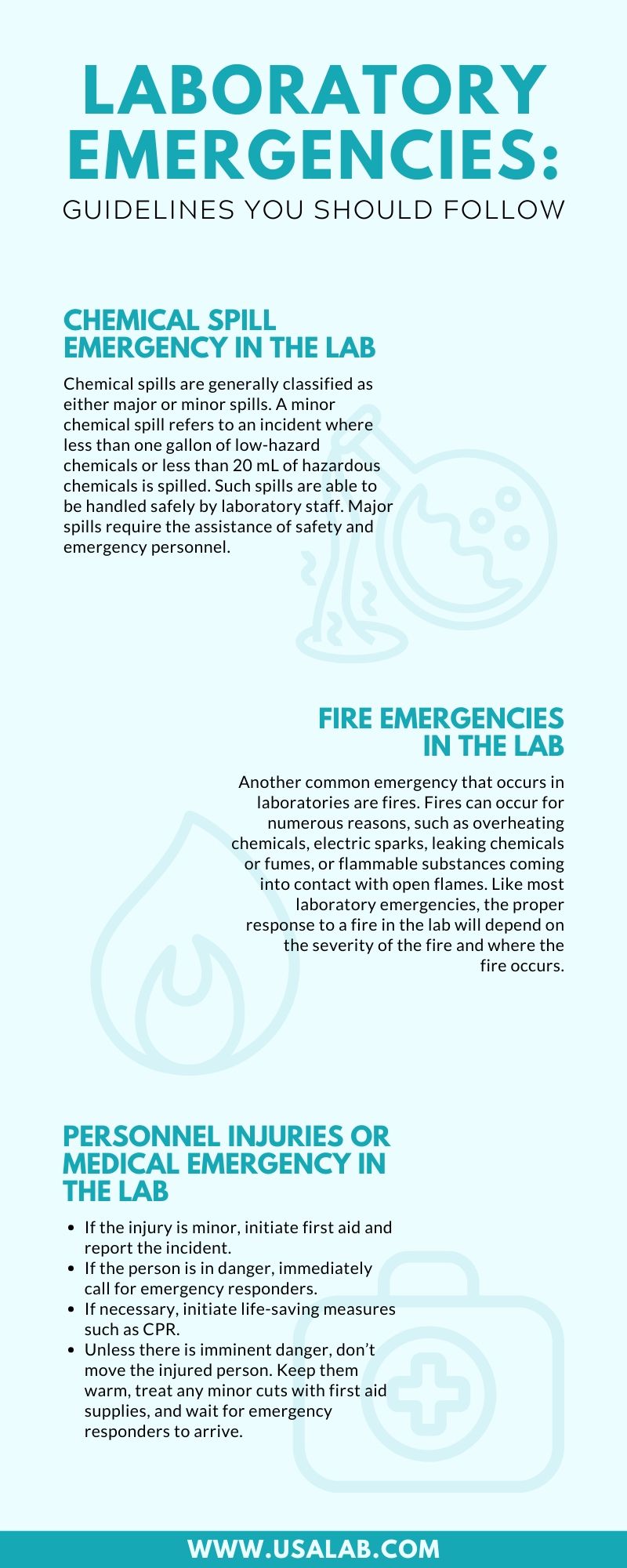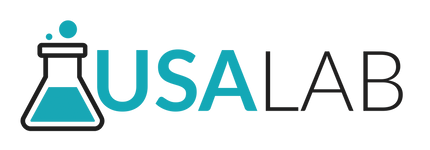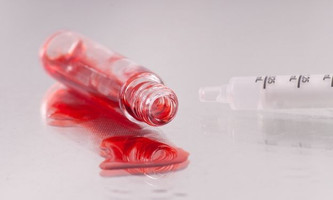Laboratory Emergencies: Guidelines You Should Follow
May 13th 2020
When working in a laboratory, one is exposed to several dangers such as fires, chemical spills, and potential electrical issues. While most accidents that occur in laboratories are preventable, there is always the potential for an emergency situation to occur—no matter how much you prepare. As such, it is important to also be aware of proper emergency response protocol. Familiarizing yourself with some of the most common laboratory emergencies and the proper response guidelines you should follow to minimize harm when they occur will help protect the safety of your lab personnel.
Chemical spill emergency in the lab
In laboratories that deal with chemicals, chemical spills are the most common emergency situation. The proper emergency response guidelines for a chemical spill will depend largely on the severity of the spill.
Chemical spills are generally classified as either major or minor spills. A minor chemical spill refers to an incident where less than one gallon of low-hazard chemicals or less than 20 mL of hazardous chemicals is spilled. Such spills are able to be handled safely by laboratory staff. A major chemical spill is when over one gallon of low-hazard chemicals or more than 20 mL of high-hazardous chemicals are spilled. Major spills require the assistance of safety and emergency personnel. The proper guidelines for responding to each type of chemical spill are listed below.
Minor chemical spill guidelines
- Ensure all personnel in the immediate area are aware of the spill.
- Put on proper personal protective equipment such as gloves, safety goggles, and a laboratory coat to prevent bodily exposure to the chemicals.
- Avoid breathing vapors from the chemical spill—especially if they are volatile or toxic.
- If the chemical is flammable, turn off heat or ignition sources in the area.
- Use a spill kit to confine, neutralize, and absorb the chemical spill. Then place the residue in a suitable container and dispose of it as chemical waste.
- Refill the spill kit so it is ready for future use.
Major chemical spill guidelines
- Alert all nearby people of the major spill and immediately evacuate the area.
- Call emergency responders or EHS for assistance.
- Turn off power to heat sources if spilled chemicals are flammable.
- Close doors and secure the area where the spill occurred.
- Wait for emergency personnel to arrive—don’t attempt to clean up the spill yourself.
- Once they arrive, assist the emergency personnel in locating the area where the spill occurred.
Fire emergencies in the lab
Another common emergency that occurs in laboratories are fires. Fires can occur for numerous reasons, such as overheating chemicals, electric sparks, leaking chemicals or fumes, or flammable substances coming into contact with open flames. Like most laboratory emergencies, the proper response to a fire in the lab will depend on the severity of the fire and where the fire occurs. Below, you will find proper response guidelines for several different emergency fire scenarios that may occur in a lab.
Small fire
- Small fires can often be extinguished without the need for evacuation. When a small fire occurs, identify the proper fire extinguisher type to use. Using the wrong type of fire extinguisher will be ineffective for putting out the fire. The main types of fire extinguishers and their appropriate uses are as follows:
- Class A extinguishers: ordinary combustibles such as wood or paper.
- Class B extinguishers: flammable liquids such as grease, oil, or gasoline.
- Class C extinguishers: electrically energized fires.
- Class D extinguishers: combustible metals such as aluminum, sodium, and potassium.
- Multipurpose extinguishers: suitable for two or more different types of fires depending on the classes they are labeled with, such as A-B, B-C, or A-B-C.
- Once the proper fire extinguisher for the situation has been identified, trained personnel should use the fire extinguisher to put out the blaze.
- In the case that the fire isn’t able to be extinguished, an easy exit should be located.
- If you can’t extinguish the fire, evacuate the area and call emergency services.
Fire involving an individual’s clothing
- If fire has caught on an individual’s clothing, they should refrain from running, as doing so may accelerate the flame.
- If there is a safety shower present, the individual should immediately utilize it to help extinguish the flame.
- If there is not a safety shower present, the individual should stop what they are doing, drop to the floor, and roll around on the ground to smother the flame. While doing so, they should cover their face with their hands for protection.
Large fire
- Locate a safe exit and evacuate the area immediately. When evacuating, take the stairs and refrain from using elevators.
- If there is heavy smoke, use a wet towel to cover your mouth and nose.
- Pull fire alarms and notify people as you exit the facility.
- If possible, turn off the electric power to the facility.
- Once you have ensured your own safety, call emergency responders for help.
Personnel injuries or medical emergency in the lab
There are several different types of injuries that laboratory staff may sustain while working in the lab. Aside from burns caused by fire or chemical spills, personnel may also experience bleeding, electric shock, or poisoning from ingesting toxic substances. In the case that such injuries or medical emergencies occur, follow these general response guidelines.
- Calmly assess the situation and ask the person (if they are conscious) or any witnesses about what happened to get a gauge of the situation. If the person is alone and unresponsive, look for signs of injury.
- If the injury is minor, initiate first aid and report the incident.
- If the person is in danger, immediately call for emergency responders.
- If necessary, initiate life-saving measures such as CPR.
- Unless there is imminent danger, don’t move the injured person. Keep them warm, treat any minor cuts with first aid supplies, and wait for emergency responders to arrive.
In addition to familiarizing yourself and your staff with common laboratory emergencies and the proper response guidelines to follow, another way to help enhance lab safety is by investing in quality equipment. At USA Lab Equipment, we stock a wide variety of high-quality new and used lab equipment—from lab heaters and chillers to turnkey systems. For more information regarding our equipment options, contact us today.


